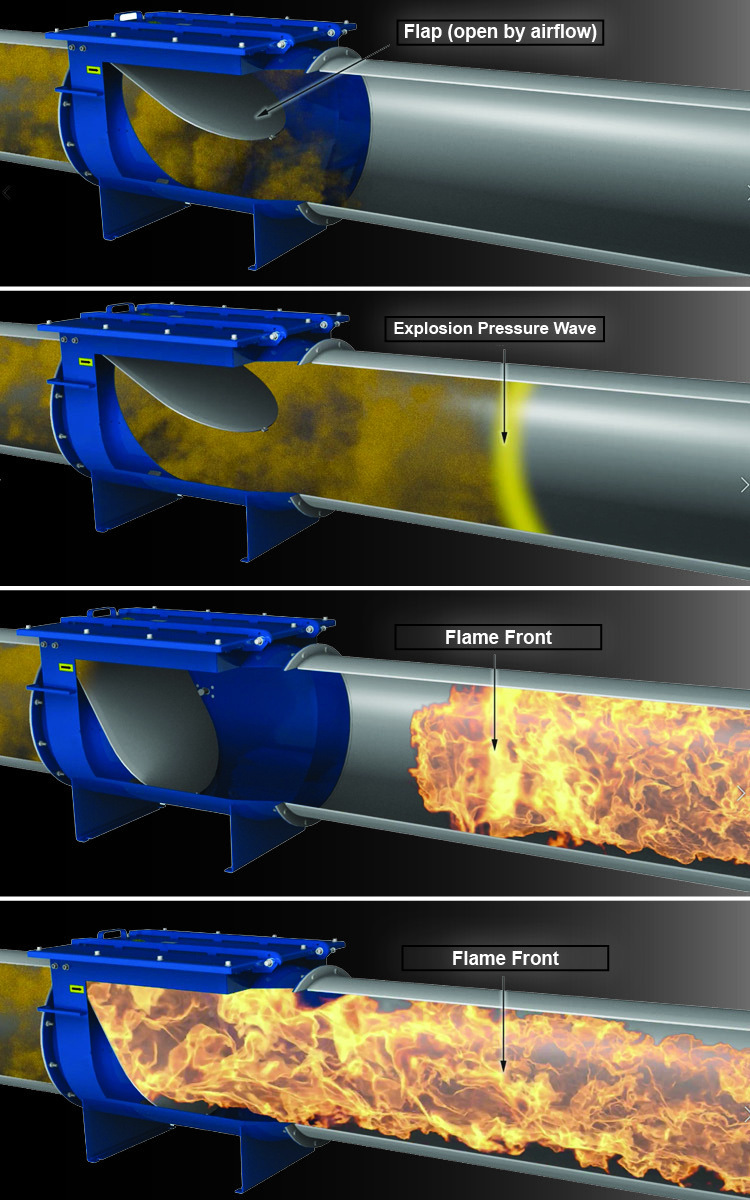
The isolation flap valve, as shown in Figure 1, consists of a cylindrical housing with a covered inspection port and a flap blade (or plate) that rotates on a shaft as the valve opens and closes. The valve is mounted in the horizontal inlet duct just upstream from the dust collector. The minimum and maximum distances from the dust collector inlet are determined by the valve manufacturer and confirmed through independent, third-party testing.
The valve's operation is passive (or flow actuated), meaning that no external input device is required to close the flap blade when a deflagration occurs. Typically, when no air is flowing in the system, the isolation flap valve's default position is closed. When process air is flowing downstream during normal operation, the air pushes the flap blade open and passes through the valve to the dust collector. If a deflagration occurs in the dust collector, the pressure wave created causes the process air to reverse and flow upstream in the system. The pressure wave rapidly pushes the flap blade closed, preventing the deflagration's slightly slower-moving flame front from propagating upstream past the valve and causing secondary explosions.
Because of the isolation flap valve's widespread use, in 2014 the NFPA revised NFPA 69 to include a new section (Section 12.2.3) on flow-actuated flap valves. This new section details flap valve and system design criteria, application limits, and system certification requirements including:
Flap-blade locking. The flap valve must be equipped with a locking or latching mechanism to prevent the flap blade from reopening during a deflagration. With no locking mechanism in place, the pressure wave generated by a deflagration could cause the flap to reopen or bounce as it closes against the valve housing. This could allow flames and uncombusted material to travel past the flap blade and ignite additional upstream material, leading to a secondary explosion.
Process interlocks. The flap valve must provide for process interlocks to signal an immediate, automatic process shutdown should the valve close due to a deflagration. An interlock is typically a 24-volt DC switch that's connected either to an interface panel or through a relay to a PLC. When the valve closes, the switch is tripped, shutting down the process and ensuring that feed material doesn't continue to flow into the system and fuel a subsequent explosion or fire.
Continuous monitoring. The flap valve must provide a continuous monitoring signal to ensure that the valve's operation isn't compromised by dust accumulation. While the process is running, dust can accumulate in the flap valve and prevent the flap blade from fully closing and sealing during a deflagration. This could allow flames or burning material to pass upstream and cause a secondary explosion.
Mounting an accumulation sensor at the valve's base to continuously sense dust deposits meets this requirement. The sensor is typically wired into a PLC or interface panel, which initiates an immediate process shutdown if dust deposits are detected. Some sensors allow you to adjust the sensitivity depending on the material and desired accumulation thickness, which can help to eliminate process shutdowns from minor material accumulation.
Some flap valves rely on flap-blade-position sensing to indicate whether the valve is open or closed, but this doesn't necessarily meet NFPA 69 requirements. A flap-blade-position sensor can tell you generally whether the flap blade is open or closed but can't determine if dust accumulation inside the valve will prevent the valve from closing fully and can't detect dust accumulation while the process is running. Increasing the inspection frequency also doesn't qualify as continuous monitoring or meet the requirements.
The only alternative to the continuous-monitoring requirement is a documented risk assessment along with an inspection protocol and frequency that's acceptable to the authority having jurisdiction (AHJ). You won't know what, if any, risk assessment and inspection protocol and frequency will be acceptable to the AHJ when you're purchasing the valve, however, and a risk assessment is difficult to provide, given the many possible variations in process operating conditions such as material, particle size, humidity, temperature, and airflow. Also, the inspection requirement means that you'll have to frequently shut down the process and open and visually inspect the valve to ensure that no dust is accumulating inside, which may be difficult depending on the valve's physical location and costly due to increased downtime.
To learn about explosion isolation system certification, read the article "NFPA requirements for using an isolation flap valve on your dust collection system" by David Grandaw, IEP Technologies. You can also find articles listed under "Safety" and "Dust collection" in PBE's article archive.


